How to Measure Children’s Feet at Home: UK Fit Guide for Toddlers & Juniors
Updated on:

A perfect fit in your child's footwear is crucial for comfort, posture, and development. With growing feet and constant movement, it’s important to know how to measure children’s feet accurately at home. Children often experience growth spurts, and even a few millimetres can make a big difference in how their shoes fit and feel. Choosing the correct size supports natural development, helps avoid discomfort, and reduces the likelihood of issues such as tripping, pressure marks, or long-term posture concerns.
In a world where online shopping is increasingly common, being confident in how to measure children's feet at home gives parents the freedom to buy shoes without worry. This guide will walk you through every step: how to measure foot length and width, how to use Clarks' foot gauges for both toddlers and juniors, and how to use the Clarks size calculator to find the right size every time. Whether your child needs trainers, casual shoes, or school footwear, getting the fit right is the foundation for happy feet.
Why Accurate Foot Measurement Matters
Children’s feet grow quickly, especially in the early years. Wearing ill-fitting shoes can lead to discomfort, poor walking habits, and even long-term foot problems. Shoes that are too small may cause blisters and cramping, while oversized shoes can lead to instability and frequent tripping.
Footwear that doesn't fit properly can also affect balance, coordination, and overall physical development. Since children are often unaware of the discomfort caused by tight or loose shoes, it's up to parents and guardians to proactively monitor fit. Inadequate fit may also discourage active play, limit walking distances, or contribute to toe deformities like overlapping or bunions over time.
By learning how to measure children's feet correctly, parents can ensure their little ones wear shoes that support their growth, encourage healthy movement, and keep them confident on their feet. Regular measuring also helps catch changes in foot size early, ensuring timely updates to their footwear and avoiding guesswork during back-to-school or seasonal shopping.
What You Need Before You Begin
Gather these items before measuring your child’s feet at home:
- A flat surface (like a floor or low table) that allows your child to stand or sit safely
- Socks your child would normally wear with shoes to replicate real-life fit
- Pen or pencil for marking and recording measurements
- A sheet of paper for marking toe positions, or optionally, a printable foot measuring chart if you prefer a guided tool
- A measuring tool: either the Toddler Foot Gauge or Junior Foot Gauge, depending on your child’s age
Using the correct tools and environment ensures that the measurements you take are as accurate as possible. Make sure the area is well-lit and distraction-free, and that your child is calm and cooperative. It may help to turn the measuring process into a fun activity or game to keep younger children engaged. Ensuring they wear their usual socks is important, as different sock thicknesses can slightly affect the size needed for a comfortable fit.
How Can I Measure My Child's Feet at Home?
Measuring your child’s feet at home is simple and empowering with the right approach. Whether you're preparing for a new school term or replacing shoes that have suddenly become too tight, accurate home measurement gives you the freedom to shop with confidence.
There are two main aspects of foot measurement: length and width. Getting both dimensions right helps ensure a snug but comfortable fit that supports natural movement and healthy development. The steps below explain how to measure your child’s feet effectively, with specific techniques depending on their age group.
How to Measure Toddlers' Feet at Home?
For pre-school children, it's best to measure their feet while they are seated. Toddlers may find it difficult to stand still, so a seated position not only keeps them comfortable but also ensures more accurate results. Choose a time of day when your child is well-rested and calm to make the process easier.
- Position your child safely: Sit your toddler on your lap or in a secure chair with their feet dangling freely and naturally. Make sure their socks are properly adjusted and not bunched up.
- Prepare the gauge: Use the Toddler Foot Gauge. This tool is specially designed for smaller feet and gives quick, reliable results. Confirm your child is wearing the socks they usually wear with shoes.
Measure the length
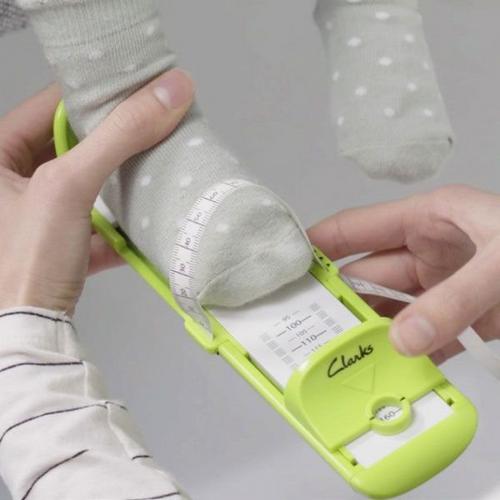
Step 1 Place one foot in the gauge with the heel resting firmly against the heel stop.
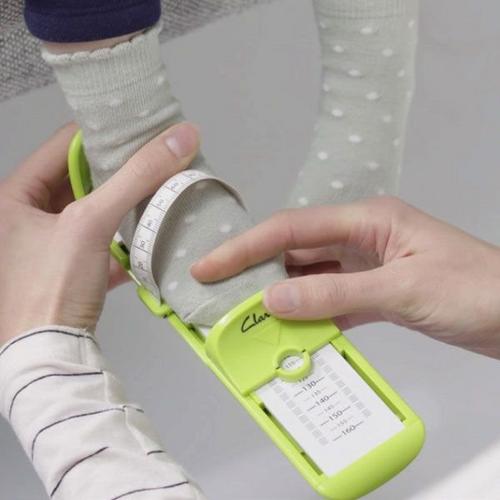
Step 2 Flatten the toes gently to their natural resting position.
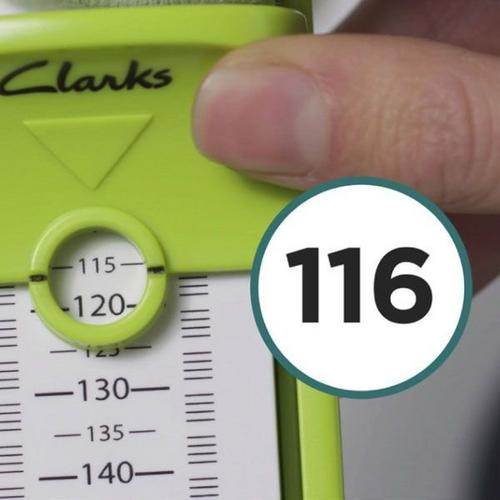
Step 3 Slide the toe bar until it just touches the tip of the longest toe without pressing. Read and record the length shown in the viewing window or marked scale.
Measure Foot Width
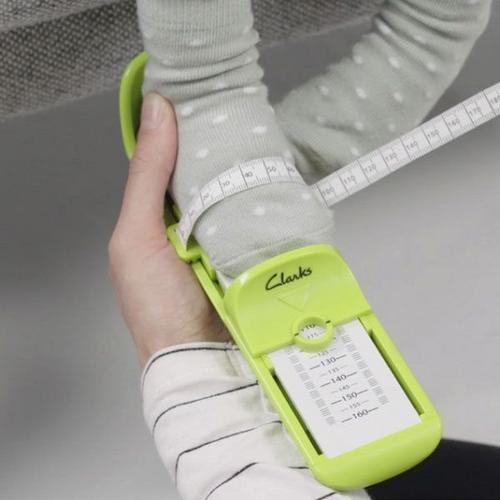
Step 1 Place one foot in the gauge with the heel resting firmly against the heel stop.
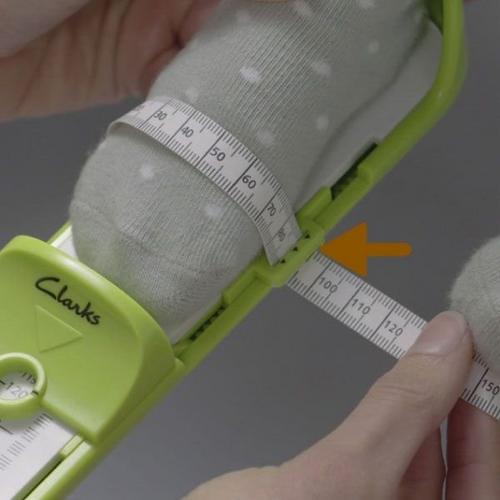
Step 2 Flatten the toes gently to their natural resting position.
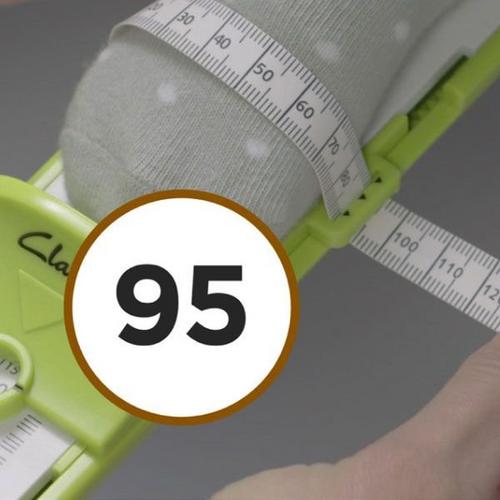
Step 3 Slide the toe bar until it just touches the tip of the longest toe without pressing. Read and record the length shown in the viewing window or marked scale.
Repeat with the other foot: Foot sizes can vary, so it’s important to measure both feet individually. When choosing a shoe size, always go with the larger length and width for the best fit.
How to Measure Junior Feet at Home?
For older children, it's best to take measurements while they are standing. At this stage of growth, their feet are more developed and need to be assessed under natural weight-bearing conditions to get the most accurate fit. Standing ensures the foot is fully extended and gives a better idea of how shoes will feel during everyday activities.
- Ensure proper posture: Ask your child to stand upright on a flat, hard surface with their weight evenly distributed across both feet. This helps lengthen the foot slightly and gives a more realistic sense of size compared to a seated position.
- Select the correct tool: Use the Junior Foot Gauge for this age group. It's designed for children with longer feet and provides more precise measurements for growing juniors.
Measure the length
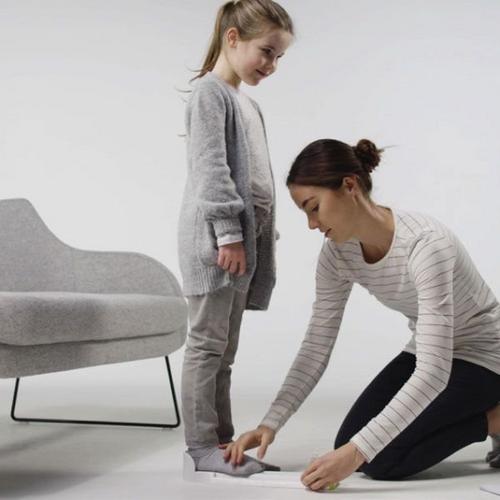
Step 1 Insert one foot into the gauge and make sure the heel is firmly pressed against the heel rest.
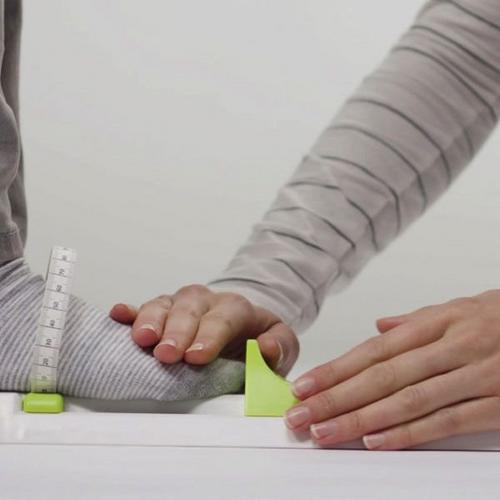
Step 2 Encourage your child to relax their toes.

Step 3 Slide the toe bar carefully until it rests against the tip of the longest toe. Read the length measurement from the viewing window and write it down.
Measure Foot Width

Step 1 Locate the ball of the foot, which is usually the widest point.
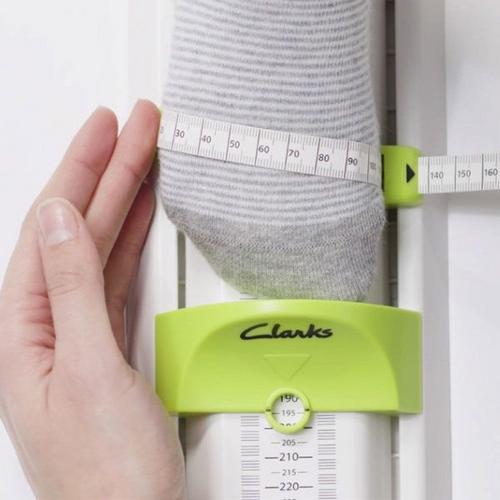
Step 2 Pull the width tape gently across this area, ensuring it's neither tight nor loose.
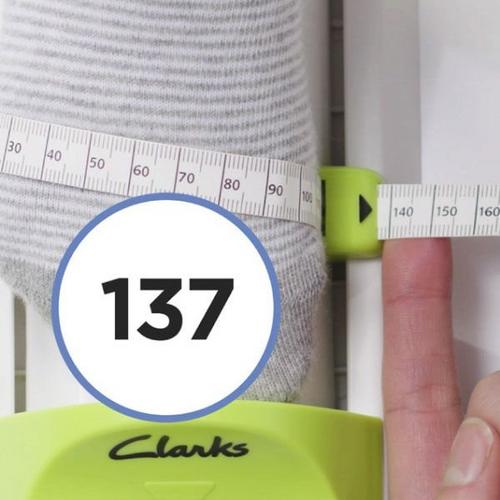
Step 3 Observe where the arrow points to determine the correct width fitting.
- Repeat for the second foot: Many children have one foot slightly larger than the other. Always base the shoe selection on the longer and wider foot to ensure the best possible comfort and fit.
By taking accurate measurements while your child is standing, you're accounting for natural pressure, arch flexibility, and daily wear scenarios. This is particularly important when shopping for structured footwear like trainers or school shoes, where a proper fit can support long days of movement and activity.
How to Measure Children’s Feet Width UK?
In the UK, children’s shoe widths are categorised using letter codes to represent varying foot shapes. These include F (standard width), G (wide fit), and H (extra wide fit). Getting this part of the measurement right is just as important as measuring length. A shoe that’s too narrow can cause pinching and pressure points, while a shoe that’s too wide may lead to instability and heel slippage. Proper width ensures that the shoe hugs the foot comfortably, providing support while allowing natural movement.
To measure children’s feet width properly:
- Make sure your child is wearing appropriate socks that match the type they’ll typically wear with the shoes.
- Use the width tape on the gauge, if available, or a soft flexible measuring tape. Ensure the tape is not twisted and lies flat against the foot.
- Measure across the widest part of the foot, usually from the ball of the foot at the base of the big toe to the opposite side.
- Do not pull the tape tight; it should sit gently against the foot without digging in.
- Take note of the reading and refer to the width guide provided with the measuring tool to find the appropriate letter width.
It’s not uncommon for each foot to have a slightly different width, so always go with the wider measurement to avoid discomfort. Ensuring a good width fit is especially important for structured shoes like school footwear or leather styles, where the material won’t stretch as easily over time.
Using the Clarks Shoe Size Calculator
Once you have both the length and width of your child’s feet, the next step is to convert these measurements into a UK shoe size. Clarks offers a convenient online shoe size calculator where you can input your results to find the recommended fit. This tool adjusts for width and growth allowances, giving you confidence in your choice.
The calculator is user-friendly and ideal for busy parents who want quick and accurate results. Simply select whether you're measuring in millimetres or using Clarks' foot gauge readings, enter the foot length and width for each foot, and the tool will instantly suggest the most appropriate size. It takes into account the natural difference in foot size between left and right and always recommends the size that accommodates the larger foot.
One of the key advantages of the Clarks size calculator is its ability to factor in a small growth allowance. This ensures your child’s shoes won’t become too tight too quickly, while still maintaining a secure and comfortable fit. It’s a particularly helpful feature during periods of rapid growth or when purchasing seasonal shoes in advance.
Using the calculator also reduces the risk of ordering the wrong size online and having to go through returns or exchanges. It adds confidence to your purchase decisions, particularly if you’re shopping for school shoes, formal shoes, or special-occasion footwear where an accurate fit is essential.
What to Do if You Don’t Have a Gauge?
If you don’t have access to a foot gauge, you can still measure your child’s feet using a printable chart or a ruler and measuring tape. While a gauge offers the most precise fit, this alternative method is a reliable way to get close measurements when shopping online or between in-store visits.
- Place a blank sheet of paper on a flat surface, with one side firmly against a wall.
- Have your child stand upright with their heel touching the wall and their foot flat on the paper. Ensure their weight is evenly distributed across both feet.
- Mark the tip of the longest toe with a pencil. Double-check that your child’s toes are relaxed and not curled.
- Remove the paper and use a ruler to measure the distance from the wall edge to the toe mark in millimetres. This is the foot length.
- For width, take a soft measuring tape and wrap it gently around the widest part of the foot (usually across the ball). Do not pull too tightly.
- Repeat the process for the other foot.
- Use Clarks' online guides to convert your recorded length and width into the appropriate UK shoe size.
If you're using a printable foot measuring chart, follow the specific instructions included on the sheet to ensure the scale is correct. Make sure to print it at 100% size without any scaling adjustments in your printer settings.
This manual method works well for one-off checks or occasional sizing. However, if you plan to measure regularly or have multiple children to fit, investing in a proper measuring tool like a foot gauge may provide added accuracy and convenience.
Fitting Tips After Measuring
- Buy shoes based on the larger foot for comfort and to reduce pressure points.
- Measure every 6 to 8 weeks for toddlers and every 3 months for older children. Growth spurts can happen quickly, especially in the early years.
- Avoid choosing shoes that are too large thinking they’ll "grow into them." Oversized shoes can cause tripping and prevent proper foot support.
- Look for features like adjustable fastenings and breathable materials. These provide flexibility, especially if your child is between sizes or wears orthotic insoles.
- Ensure there is around a thumb’s width of space between the longest toe and the end of the shoe. This allows for movement and slight growth without compromising fit.
- Pay attention to how your child walks in new shoes. They should walk naturally without dragging their feet or adjusting their stride.
If your child's new shoes feel tight even after measuring correctly, check out our guide on How to Stretch School Shoes at Home to help ease the fit safely.
Finally, try shoes on towards the end of the day when feet may be slightly swollen, this mimics real-world conditions and ensures a more accurate fit.
When to Get a Professional Fit?
While home measuring is convenient, it’s still a good idea to visit a Clarks store for a professional fitting, especially:
- If your child is between sizes and you're unsure which option to go for
- If you notice rubbing, red marks, or complaints of discomfort when wearing new shoes
- When transitioning to new footwear types, such as kids' school shoes, winter boots, or formal footwear
- If your child has particularly narrow, wide, or high-arched feet that may require tailored fitting support
Our trained fitters use the same tools and follow similar methods to confirm your measurements and make personalised recommendations. They’re also equipped to spot early signs of foot development issues, like overpronation or pressure imbalances, that might benefit from specific footwear features.
A store visit can also be a great learning experience for your child, helping them become more aware of how shoes should fit and feel. For special occasions or first-time walkers, a professional fitting gives added peace of mind that you’re getting the most accurate fit possible.
Final Thoughts
Measuring children's feet at home saves time and ensures comfort and support. By using the right tools like the Toddler or Junior Foot Gauge, keeping track of both length and width, and leveraging the Clarks size calculator, you can confidently shop for the perfect fit.
Whether it’s their first walkers, kids' school shoes, or weekend trainers, the right size makes all the difference. Properly fitted shoes encourage healthy development, reduce the chance of foot pain or posture issues, and give your child the confidence to explore, play, and learn comfortably.
Make measuring a routine part of your family’s life, especially during times of growth or changing seasons, and you’ll always be one step ahead when it comes to selecting the right kids' shoes. And when in doubt, don't hesitate to get professional support in-store to double-check your measurements and ensure your child gets the best fit possible.—especially during times of growth or changing seasons, and you’ll always be one step ahead when it comes to your child’s footwear. And when in doubt, don't hesitate to get professional support in-store to double-check your measurements and ensure your child gets the best fit possible.